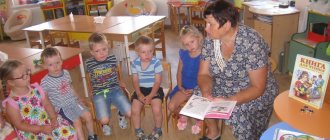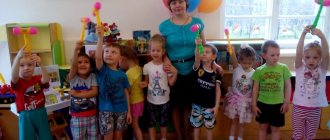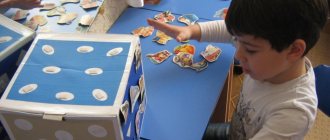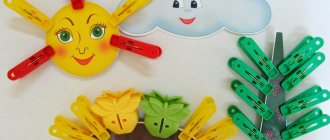Goals and objectives
Sedentary entertainment is aimed at reducing the intensity of physical activity and a gradual transition from a state of excitement to calm activity. In them, the teacher does not need to explain the rules; it is enough to independently demonstrate the movement several times or demonstrate it on any participant.
Children
In kindergarten, any form of activity is designed to diversify preschoolers. Sedentary games are no exception. Memory, attentiveness and reaction develop in a relaxed manner, and characters taken from folk tales introduce children to folk traditions.
Note! In winter they are held indoors without fail. They practice on the site near the veranda or inside it in the spring, summer and autumn days.
Sedentary games in the senior group are aimed at:
- Introducing the habit of changing active activities to low-intensity activities.
- Increased verbal-logical memory (reproduction of rules dictated aloud).
Low mobility games in the preparatory group - a card index with goals.
Card index of sedentary games
| Name | Target | Description | Note |
| Bubble | Development of discipline, attention, ability to act on command | Children stand in a circle and hold hands. The teacher reads the poem; while the reading is happening, the children move away, enlarging the circle. As soon as the words “The bubble burst” are pronounced, the kids should lower their hands and pronounce the sound “ssss”, imitating a deflated balloon. | Poem: “Blow up a bubble, Blow up big, Stay like that and don’t burst.” The game takes place 2-4 times. |
| Kitty | Develops dexterity and artistic qualities | The task is given - to portray a cat, crawling on all fours. When called, stop and look around, turn your head or tilt it (drink milk). You can also add tasks in which the cat crawls between your legs, climbs to heights, and purrs. | |
| Attractions | Thinking and memory are developing | Place children at the table, fingers should be on the surface. The teacher names any objects, animals, birds, etc. When a flying object is named, the kids must raise all their fingers up. | |
| Ocean is shaking | Attention and discipline develop, children learn to follow the rules of the game | Chairs are placed, the number of which is 1 less than the number of players. At the verbal command “the sea is rough,” children run around the chairs. As soon as you hear “the sea has calmed down,” you need to take a chair. There isn't enough chair for one - he goes to drive. | It is best to play this game while walking in the summer. Children should be prevented from running too close to chairs. Also strictly monitor compliance with the rule - take a chair only when the words “the sea has calmed” are heard. |
Educational games for children 3-6 years old to learn the alphabet
Sedentary games (second junior group)
Sedentary games
"Guess by Voice"
Purpose: To train children in forming in a circle; navigate in space, develop auditory attention
How to play: The driver stands in the center of the hall and closes his eyes. Children form a circle without holding hands, walk in a circle to the right and say:
We gathered in an even circle. Let's turn around at once,
How about we say; “Skok-skok-skok” , Guess whose voice it is.
The words “skok-skok-skok” are pronounced by one child (as directed by the teacher) .
"Quiet-loud"
Goal: to develop the ability to play together, develop interest in games
Progress of the game: using a counting rhyme, a driver is selected, he stands in the center of the circle and closes his eyes. The teacher gives one of the players an object that can be hidden (lace, ribbon)
. All children except the driver know who has the item. When the driver approaches this child, the children begin to clap their hands loudly; when he moves away, the clapping becomes quieter. The game continues until the driver finds the item. If he fails to do this for a long time, then another driver is chosen.
"Bubble"
Goal: to teach children to act on the teacher’s command, to develop attention.
How to play: Children and an adult stand in a circle holding hands. Educator: Blow up a bubble. Pout big. Stay like this and don't burst out. Children gradually move back to expand the circle. When they hear the words “The bubble has burst,” they lower their hands and say “sh-sh-sh.” The game is repeated 2-4 times
"Kitty"
Purpose: the game develops artistry and dexterity.
Progress of the game:
The child crawls on all fours, pretending to be a cat. He stops and turns his head (the cat looks around), then tilts his head (the cat drinks milk). For children over two years old, you can complicate the game: the cat crawls between the legs of an adult, under a chair, climbs onto the sofa, lies down, purrs.
"Cold-warm"
Purpose: develops attention and thinking.
Progress of the game:
Children sit on the carpet with their legs folded cross-legged.
Educator: The north wind blew. It became cold, cold. (The children curl up into balls, crossing their arms over their chests.)
On signal: The sun came out. It has become warm and warm, the children are relaxing and fanning themselves. The game is repeated 2-3 times.
"Find by description"
Goal: Find by description - a game for children two to three years old. Promotes the development of observation, memory and attention of the child. Progress of the game:
Ask your child to show you what you describe to him. For example: “Please show me the object. It is round, one side is red and the other is blue. You can play with it: roll it, throw it to each other” (this is a ball).
Rules of the game: 1. Describe an object to the child: its color, shape, what it is made of, what can be done with it 2. The child guesses the description and names the object
Note
You can describe people, animals, nature - precipitation, trees... (and everything that surrounds us) and ask the child to guess who/what you are talking about.
"Girls and boys"
Goal: to develop freedom and imagination in children. How to play: Girls and boys sit opposite each other. The boys start the game. They take turns calling any girls' names. If there is a girl whose name was spoken, she stands up and says her name again and talks a little about herself. After this, it’s the girls’ turn and they start calling out the boys’ names.
Rules of the game 1. Girls and boys sit opposite each other. 2. The boys start the game. They take turns calling any names of girls 3. If there is a girl whose name was pronounced, she stands up and says her name again and talks a little about herself. 4. After this, it’s the girls’ turn and they start calling out the boys’ names.
"Amusement park"
Goal: to teach children to act according to plan; develop attention.
Children stand in pairs around the hall and perform movements in accordance with the text.
Text: Movements:
We sat on the carousel, holding hands, spinning. The carousel started spinning. We moved to the swing. Holding hands: one player stands, They flew up and down. the other crouches. Holding hands, And now you and I are swinging together: left and right, forward - We are sailing on a boat. back. We will go ashore from the boat. And let's gallop across the lawn,
Like bunnies, like bunnies. Jumping on two legs.
Stages of implementation in senior and preparatory groups
Conducting games in the older group with low mobility is divided into several periods:
- Gather the kids to start. The call is a whistle. If desired, a surprise is added - the teacher shows a small letter or a video recorded by a fairy-tale character, setting up the theme of a sedentary game selected from the card index with the goals in the senior or preparatory group.
- Start. If there was a surprise, then you should get acquainted with its contents (read the letter, watch a video from a fairy-tale character). Next, have a conversation and show with a video or photo an example of what needs to be done in the proposed game. At the same time, the teacher with expression reads a poem on the relevant topic. If the exercise is familiar to kids, invite them to guess the name from the pictures.
- The explanation in the senior and preparatory groups occurs verbally, without showing movements. Exercises familiar to children are explained in the format of questions on knowledge of the rules.
- Game process. During the first meeting, the role of the facilitator lies with the teacher. When repeating, children choose the main thing on their own, and the teacher only guides them along the way.
- At the end, it’s worth summing up and asking questions: “How interesting was the game?”; “What did you feel during the process?”
There is a chair, but I can’t sit down
Five chairs are moved in a circle, close to each other, with their backs inward. 6 people stand in front of the chairs. They turn in one direction and, at the leader’s command, begin to march around the chairs. Suddenly the manager blows a whistle (or other conventional signal). All players must quickly take their seats. Since there are only 5 chairs, and 6 players, one of them is left without a seat and is eliminated from the game. At the same time, one chair is put out of the circle (the remaining chairs are moved), and the game continues. After each signal the number of players decreases. When two players and one chair remain, the final stage of the game is played. The one who takes this chair wins.
Travel to Moscow
To play, you need chairs - one less than the number of players. The chairs are placed tightly in a circle, one next to the other, with the seats facing outward. Each player takes an empty seat. The driver does not have a chair. He walks around the players, holding a flag in his hand, and says: “I’m going to Moscow, I invite those who wish.” All the guys one by one join him. The driver says: “We are flying to Moscow by plane,” and at the same time speeds up his pace. “The plane is picking up speed,” the driver continues and starts running. “Moscow is very close,” he announces (the run slows down). "Attention, landing!" — the driver’s command is suddenly heard. At this command, everyone runs to the chairs. Everyone tries to occupy any free space. The driver also tries to take a seat. The one who is left without a place becomes the driver, gets a flag and repeats the game.
The driver can take the children away from the chairs, lead them across the entire hall, twist them in a spiral, etc. and give the command “Landing!” unexpectedly, anywhere.
Two out of three
Three pins are placed on the floor. The two players dance around them with their hands on their hips or behind their backs. On the command “Stop!” everyone tries to grab two pins. Whoever gets one loses.
Who will be faster
To play you need 15 pins of three colors, 5 pins each of, say, red, green and yellow, and 3 wooden cubes. In each cube, every two opposite sides must be colored the same colors as the pins (two sides are red, two sides are green, two sides are yellow). The players stand in a circle. The pins are placed inside the circle so that their colors alternate and so that they stand farther from one another. The players are counted on the first, second, third. The first three play first, followed by the second, etc. The next three players stand in the center of the circle facing each other, each with a cube in their hand. At a signal, they throw the cubes onto the floor and watch which side they fall on. If two or three dice show the same color, then players try to collect pins of that color as quickly as possible. If there are three different colors on the top sides of the dice, the dice are thrown again.
The one of the players who turns out to be more agile may manage to take two or three pins out of five, while someone else may miss even one. For each pin taken, a point is counted.
The game is played in two rounds. Only those who scored two or three points in the first round participate in the second round. The players with the most points win.
Elusive cord
Two players sit on chairs with their backs to each other, at a distance of 2-3 m. A rope is stretched under the chairs. At the signal, you need to jump up, run around both chairs, making three full circles around them, then sit on your chair, bend over and pull the rope towards you. Whoever grabs the rope faster wins (Fig. 1). Everyone should run to the right. You cannot touch chairs while running.
Rice. 1. The Elusive Cord
First we need to do a rehearsal. To prevent the players from making a mistake and grabbing the rope ahead of time, the leader counts the turns out loud: “One, two, three!” After the count of three, you can sit on a chair and try to pull the rope.
The competition is held three times. The winner is the one who manages to pull the cord two or three times.
You can make a change to the game: do not run around the chairs, but jump on one leg (only one revolution), then sit down and try to pull the rope.
There is another fun version of this game. Both participants are blindfolded. On command, they must stand up, walk to the opponent’s chair, feel it, sit down and pull the rope.
Don't get confused
The leader puts several guys in a row and, turning to them, says: “Try to do this exercise (demonstrates). Only at first glance it may seem very simple and easy. Actually this is not true. Place your hands on your knees, clap your hands in front of your chest, grab your nose with your right hand and your right ear with your left hand, then clap your hands again, grab your nose with your left hand and your left ear with your right hand. Repeat the exercise in the same sequence several more times, gradually increasing the pace. Just don’t confuse where your nose is and where your ear is, where your right side is and where your left side is.”
Nose - Ear - Nose
Addressing the participants in the game, the leader says: “Touch your nose with the index finger of your right hand and say “Nose.” Once again, again. I'll do the same. But if I say, for example, “Forehead,” you should immediately touch your forehead. It's clear? Let's start! Nose-nose-nose-nose-ear!” Having said “Ear,” the leader points his finger to his chin, and many unwittingly do the same thing.
Missing stool
Two stools are placed at a distance of 2-3 m from one another. Players sit on them blindfolded. At the leader’s command, they stand up and take 6-8 steps forward. After this, everyone must make three full turns in place and return to their stool.
This task is not easy to complete. Very often, players lose direction and, when returning, go in a completely different direction from where they came.
Searching for a call
Two chairs are placed at a distance of 8-10 m from one another and a bell is placed on each. The players stand near the chairs, facing each other. They are blindfolded. At the leader’s signal, each of them must go forward, go around his friend’s chair and, returning back, find his bell and ring it. The one who completes this first wins. If there are no bells, you can replace them with rattles or sticks, which you need to knock on the chair.
Cubes in places
A line is drawn on the floor, and 2-3 steps from it, 3-5 circles (according to the number of cubes) are drawn in different places. The distance between the circles is 2-3 m, the diameter of the circles is 20-30 cm.
The players stand on the line, receive a bag of cubes in their hands and try to remember the location of the circles. Then they are blindfolded and asked to place the cubes in circles. The one who manages to do this wins.
Can't see anything
In the middle of the site, 8-10 pins are placed randomly at a distance of 70-80 cm from one another. Skittles are trees in the forest. The players are blindfolded. They must go to the other side of the site between the trees without touching them. Anyone who touches the pin and drops it receives a penalty point.
By the end of the game, when several players pass through an imaginary forest at night, the winner is determined. It will be the one who received fewer penalty points.
Holding the ball with your head
Two or three pairs of players, standing side by side, hold hands, put a large inflatable ball on their shoulders and, pressing it with their heads on each side, run to the indicated place and back, trying not to drop the ball. The pair that successfully completes the task and returns first wins.
Comic football
You can play in a spacious room, in the hallway or on the playground. Two chairs are placed at a distance of 5-6 m from one another, with their backs facing inward. Two guys sit on chairs, facing each other. The space between the legs of the chairs is the gate. Two players have their feet tied with rope. Moving around the court with their legs tied, everyone tries to intercept the ball and drive it into the opponent’s goal. The one who does it first wins. Spectators prevent the ball from rolling away from the players.
In a small room you can play with only one goal. Everyone tries to prevent the opponent from scoring the ball into the goal, and he himself tries to do it.
Who are they
Select several heroes familiar to the children from famous fairy tales, stories, poems (for example, Pinocchio, Barmaley, Aibolit, Uncle Styopa, etc.). Write their names clearly on separate pieces of paper and pin one of these pieces of paper on each player's back. No one should know who has which note pinned. Then announce that at the signal, all the guys will disperse around the room and for three minutes everyone will try to recognize and remember as many heroes as possible.
The difficulty is that everyone needs to look at the notes on the backs of others, but at the same time not show their own note. It is necessary to warn the children that during the game they cannot stand still, lean their backs against the wall, hold the children back with their hands, but must continuously move and at the same time dodge in order to hide their inscription.
Three minutes later a second signal is given. The players stand with their backs to the wall. Everyone is given paper and pencil and asked to write down the names of those heroes whom he managed to spy.
The winner is the one who wrote down the most names and at the same time managed to hide the name assigned to him.
In a small room, you should not include more than 3-5 people in the game.
Rope
The players form a circle, holding the tied cord with their hands. The driver, moving inside the circle in different directions, tries to unexpectedly hit someone on the hand. Players must quickly withdraw their hands to avoid being hit (but immediately return them to their previous position). The one whom the driver hit takes his place inside the circle, and the game continues.
Three movements
“Let everyone remember the three movements that I will show,” says the leader. - First: bend your arms at the elbows, hands at shoulder level; second, extend your arms forward at shoulder level; the third is to raise your hands up.
The leader shows the movements, everyone repeats them two or three times to remember the number of each movement. Then the game begins. The leader shows one movement while calling out the number of another. The players must make those movements that correspond to the named number, and not those that the leader shows, but inevitably get confused when looking at him.
Dwarfs and giants
The players stand in a circle. The leader agrees with the children that if he says “giants,” everyone should rise on their toes and raise both hands up; if he says “dwarfs,” everyone must squat down and stretch their arms forward. First, the leader conducts a rehearsal, while he may not make any movements. Then, while conducting the game, the leader can from time to time show movements at random. Whoever makes a mistake receives a penalty point.
If the game is played when the guys are sitting, you can change the movements: on the word “dwarfs” - they bring their hands together, joining their palms, on the word “giants” - they spread their arms wide to the sides.
Prohibited movement
The players form a circle. The leader agrees in advance with them what movements cannot be made, for example: sit down, clap your hands, wave your arms. Then, to the music, the leader shows various movements that the players must exactly repeat after him. The more varied and fun these movements are, the more interesting the game. Suddenly the manager shows a prohibited movement. One of the players who inadvertently repeats it will then have to dance, sing, or read the poem at his own discretion.
You can complicate the game: agree that there are two movements that cannot be repeated, but others must be done instead. For example, when the leader puts his hand on the back of his head, the players should sit down cross-legged, and when he leans forward, they should clap their hands twice. Before the game starts, all movements must be thoroughly rehearsed.
Air, water, earth, wind
The players stand in a circle, the driver stands in the middle. Approaching one of the players, the driver says one of four words: “air”, “water”, “earth”, “wind” - and counts to 5.
During this time, the player must name (depending on the word given to him) a bird, fish, animal, or spin around in place (wind). Those who did not have time to give an answer leave the circle. Then the driver turns to someone else, etc. Suddenly, instead of the four indicated words, the driver says “fire” to someone. With this word, all players must change places and the driver takes someone else’s place in the circle. The last one, who did not have time to stand in the circle, becomes the driver.
Repeated
One of the players names an animal, say a lion. The next one repeats: “Lion” - and adds the name of another animal: “Tiger”. The third repeats: “Lion”, “Tiger” - and adds: “Rhinoceros”. And so each subsequent player, having listed all the previously named animals, adds one more new name. If someone fails to repeat the names of all the animals or mixes up their order (the judge monitors this), he is eliminated from the game. The list of animals is growing. It's getting harder and harder to remember. One by one, the guys drop out of the game. The one with the better memory wins.
At the request of the players, instead of naming the animals, you can select words on other topics.
What changed
Somewhere in a visible place, 10-15 different toys (or other objects) are placed in disarray. All players look at them carefully and then leave the room. At this time, the leader moves two or three toys to other places (or removes, adds, replaces with others). Upon returning, the players must say what has changed.
You can expand the scope of observations if you make changes to the arrangement of things in the room where the children were: rearrange chairs, move books, toys to another place, rearrange flowers, open or close a window, move curtains, etc. Returning to the room, children should say what changes have occurred during their absence. The winner is the one who turns out to be the most observant and notices what others did not notice.
With a calendar sheet
All players are pinned on their chests with a piece of tear-off calendar. The sheets must be selected so that the players can complete the tasks listed below.
Assemble a team consisting of five identical days of the week (Tuesdays, Thursdays or Fridays, etc. - it doesn’t matter, the numbers don’t matter). The team that gathers first wins. (Everyone stands in a circle, raises their hands and says their day in unison.)
Assemble a team consisting of all seven days of the week (the date and month do not matter). The team that gets in line first wins.
Find yesterday (for example, “fifth of September” searches for “fourth of September”, etc.). The first couple to show up to the leader wins.
Gather so that the year 2020 is formed (or another, as directed by the leader). The winner is the team that gathers first and lines up in such a way that the required number is formed.
Gather so that the sum of the numbers on the sheets of paper equals, say, 47. The team that completes the task and comes to the leader first wins.
You can come up with many similar games with calendar sheets. They cause great activity and excitement, and great interest among the players.
Sedentary games in preschool educational institutions for preparatory and secondary groups
An example of a sedentary game "Bubble"
Examples of exercises for the middle group:
| Name | Description |
| Traffic light | You will need 3 flags of different colors. Children sit on chairs. The teacher shows a red sign - children should put their hands on their knees. On the yellow flag, clap your hands. The color green appears - stomp your feet. |
| Song of the Animal | The point is to imitate animal voices. The teacher names the animal - the children say in chorus how it “speaks.” You can take a horse, cat, dog, chicken, cow, goat. |
| Broken phone | The teacher whispers a word in the ear of the first child, who passes it on to the next child - and so on down the chain. The last person approaches the teacher and says loudly which word has reached him. |
GCD lesson on speech development in the middle group
A card index with goals and examples of sedentary games for children in the preparatory group:
| Name | Description |
| Gates | There is a development of dexterity and coordination. It takes place outside. Children break into pairs, hold hands and stand one after another, raising their arms high. The last pair passes under everyone, trying not to hit anyone, and stands in front. |
| Military figure freeze in place | A popular interpretation of the game “The Sea is Troubled.” The children freeze in the pose of any military man, the leader looks for the one who is moving. The first one who gets caught becomes the leader. |
| Who's missing? | Children's memory and speed of thinking develop. A leader is chosen from among the kids and is blindfolded. The teacher quietly asks one of the participants to leave the room. Then the presenter’s eyes are opened and asked to name the person who left the room. |
I. Low mobility game "Echo".
Children walk in a column one at a time. An adult says a phrase, and the children, like an echo, repeat the last word. For example, an adult says: “ Kukareku ” - the children answer in a drawn-out manner: “ Ku-ku .”
II. Outdoor switchgear with cubes .
| № | Initial position | Performing the exercise | Number of repetitions |
| 1. | I. p. - main stand, cubes below. | “1” - cubes to the sides; “2” - cubes up; “3” - cubes to the sides; "4" - and. P. | 6 - 7 times, average tempo, random breathing. |
| 2. | I. p . - stand with legs apart, cubes below. | “1” - cubes up - inhale; "2" - . lean forward, touch the cubes to the floor - exhale ; “3” - straighten up, cubes up - inhale ; "4" - i. n. - exhale . | 5-6 times, average pace. |
| 3. | I. p. - kneeling, cubes below. | “1” - turn to the right, place the cube at the toe of the right foot; “2” - straighten up; “3” - turn left, place the cube at the toe of your left foot; “4” - straighten up; “5” - turn to the right, take the cube with your right hand; “6” - straighten up; “7” - turn left, take the cube with your left hand; "8" - and. P. | 3 times, random breathing, average pace. |
| 4. | I. p. - sitting on the floor, arms supported behind, the cube sandwiched between the feet. | “1-2” - raise straight legs without dropping the cube; “3-4” - and. P. | 6-7 times, moderate pace, free breathing. |
| 5. | I. p . - main stand, cube on the floor. | Jumping on two legs around a cube in both directions. | 2-3 times, rhythmic breathing pace is arbitrary |
III. Game "Guess whose voice." The children stand in a circle, the driver is in the center, he closes his eyes. (We frolicked a little, everyone took their places. You, ....., guess who called you, find out.) One of the children is asked to call the driver by name (in a quiet voice) . If he guesses who called him, then they change places, if not, the game is repeated.
CARD No. 40
JUNE complex No. 4.
I. Walking in a column one at a time, on toes, hands on the belt; normal walking, hands behind head; running in all directions
II. Outdoor switchgear without objects.
| № | Initial position | Performing the exercise | Number of repetitions |
| 1. | I. p . -basic stance, hands behind head. | “1” - rising on your toes, arms to the sides; “2” - return to i. P. | 6-8 times, average tempo, random breathing. |
| 2. | I. p. - stand with legs apart, hands behind the head. | “1” - arms to the sides; “2” - turn to the right, arms to the sides; “3” - straighten up, arms to the sides; "4" - and. n. The same to the left. | 3 times, average pace, random breathing. |
| 3. | I. p. - stand with your feet as wide as your feet, hands behind your head. | “1-2” - sit down, arms up - exhale ; “3-4” - and. n. - inhale. | 6 times, average pace. |
| 4. | I. p. - stand with your feet shoulder-width apart, behind your head. | “1” - arms to the sides - inhale ; “2” - bend over to the right leg - exhale ; “3” - straighten up, arms to the sides - inhale ; “4” - return to i. p. – exhale . The same for the left leg. | 3 times |
III. Game "Fishing Rod". Children stand in a circle, at a short distance from one another. In the center, the teacher rotates a cord in a circle, to the end of which a bag of sand is tied. As the bag approaches, children jump up so as not to touch it. The one who touched the bag takes a step back and is eliminated from the game. After a short pause, the game is repeated, and all the children participate again.
Walking in a column one at a time.
CARD No. 41
JULY complex No. 1.
I. Walking in a column one at a time; walking in all directions. At the teacher’s signal, find your place in the column. Running in all directions.
II. ORU with a gymnastic stick.
| № | Initial position | Performing the exercise | Number of repetitions |
| 1. | I.p.-o. _ s., stick on the chest with an overhand grip. | “1” – stick up; “2” - stick behind the head; “3” - stick up; "4" - i. P. | 6-7 times, average pace, random breathing. |
| 2. | I.p.-o. _ s., stick below. | “1” - step to the right, stick up; “2”—lean to the right; “3” - straighten up, stick up; "4" - i. p...Same thing to the left | 3 times, average pace, random breathing. |
| 3. | I. p . - legs slightly apart, stick vertical to the floor at arm's length; hands on a stick from above. | “1-2” - intercepting the stick, squat - exhale ; “3-4” in the same way, intercepting the stick in the i. n.- inhale . | 5-6 times, the pace is slow.. |
| 4. | I. p. - stand with legs apart, stick on shoulders with an overhand grip. | “1” - stick up - inhale ; “2” - bend forward - exhale ; “3” - straighten up, stick up - inhale ; "4" - i. P. | 5-6 times, average tempo |
| 5. | I. p . - O. s., stick below with an overhand grip. | “1” - jump legs apart, stick up; "2" - and. p. Performed on the count “1-8” with a short pause. | 2-3 times, rhythmic tempo, random breathing. |





